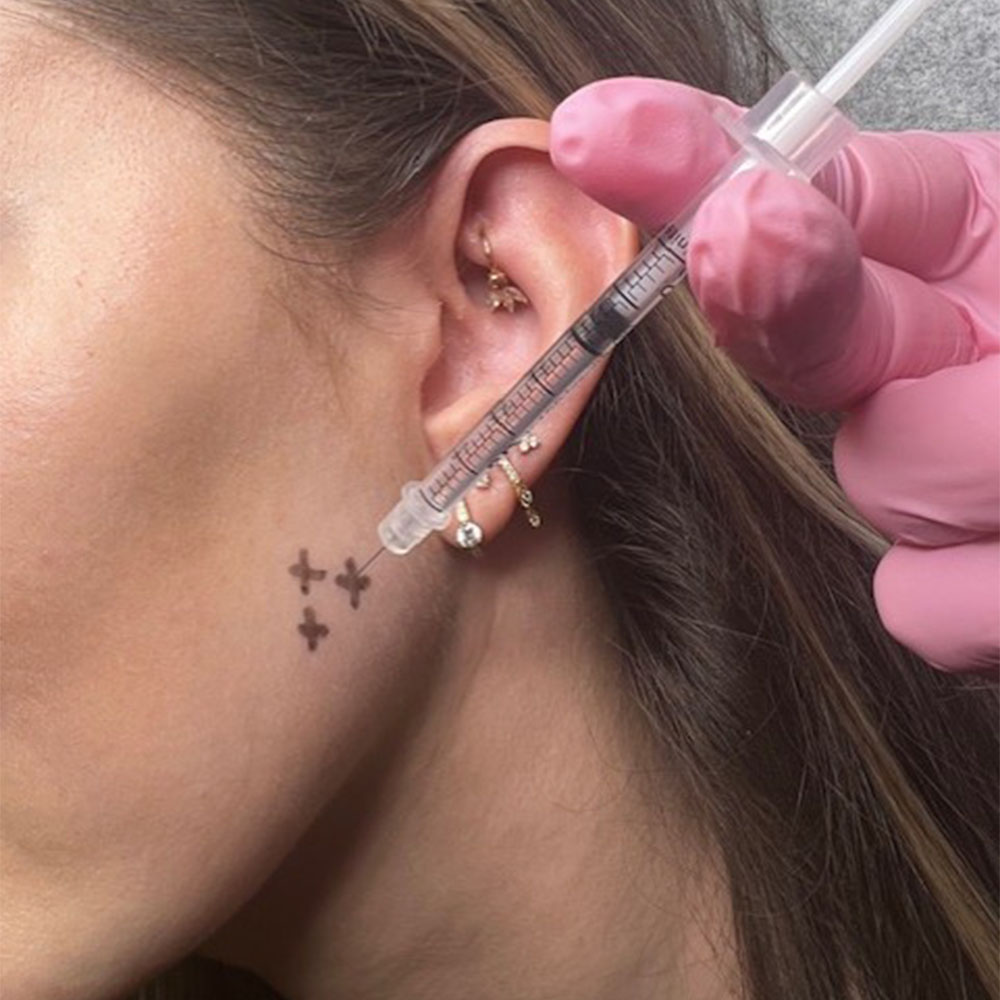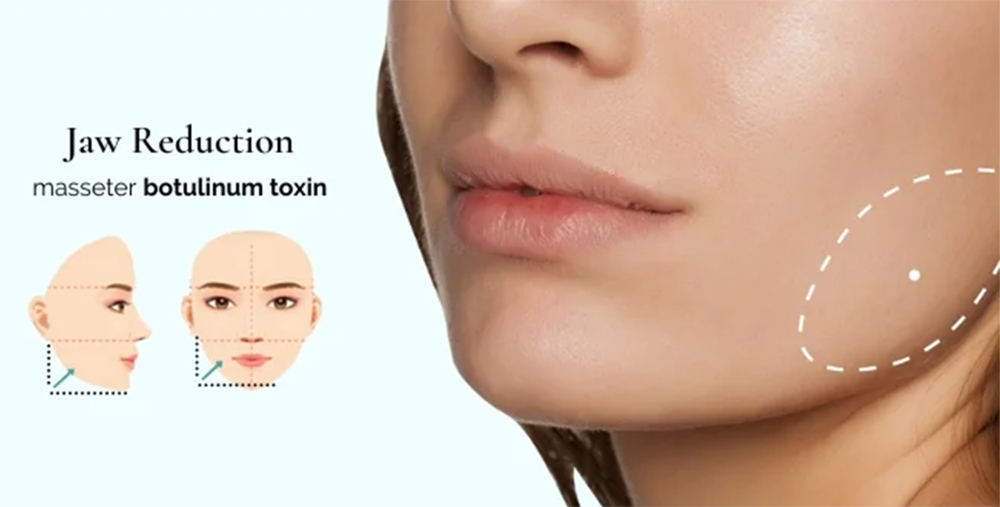
Masseter Botox is one of the most requested aesthetic treatments for both cosmetic jawline slimming and therapeutic relief from bruxism. By injecting neurotoxin into the hypertrophic masseter muscles, practitioners can deliver a more tapered lower face while reducing tension and teeth grinding.
However, as with any injectable procedure, precision is critical. When poorly executed, masseter Botox gone wrong can result in unwanted aesthetic outcomes or even functional impairment.
Key Takeaways
- Masseter Botox complications are preventable with proper training, assessment, and technique.
- Most issues resolve as the neurotoxin wears off, but patient trust hinges on early recognition and communication.
- Mastery of anatomical knowledge and complication protocols is essential for safe, aesthetic results.
What Is Masseter Botox?
Masseter Botox involves injecting botulinum toxin into the masseter muscles on each side of the jaw. This procedure serves dual purposes: softening the jawline for facial slimming and reducing muscle hyperactivity in cases of bruxism. As the treated muscles atrophy slightly over time, the result is a less square, more heart-shaped face.
Cosmetic masseter Botox is particularly popular among patients with wide lower faces or tension-related complaints. The procedure is safe when done properly, but carries the risk of masseter Botox gone wrong if dosing, depth, or placement is incorrect.

Why Understanding Masseter Botox Complications Matters
Botulinum toxin injections into the masseter require more than basic neuromodulator knowledge. They demand a detailed understanding of muscular anatomy, dose diffusion behavior, and patient-specific risk factors.
Even minor deviations in injection placement or volume can lead to significant aesthetic or functional consequences. These include asymmetric jawlines, compromised mastication, smile distortion, or lower face hollowing.
The ability to anticipate, identify, and manage Botox complications in the masseter region represents a fundamental clinical competency for aesthetic practitioners, reflecting both medical judgment and technical precision. Beyond achieving symmetry and slimming, injectors must anticipate individual variations in masseter strength, depth, and adjacent muscle interaction.
Main Causes of Masseter Botox Complications
Several key factors contribute to masseter Botox gone wrong. Many of these issues are preventable and tied directly to injector skill, patient selection, and anatomical knowledge.
Being familiar with the following causes helps practitioners avoid common pitfalls:
- Incorrect placement: Injections placed too high or too anterior can diffuse into the risorius or zygomaticus muscles, leading to a crooked smile or cheek flattening.
- Overdosing: Using too many units can weaken the masseter excessively, resulting in hollow cheeks, jaw fatigue, or chewing difficulty.
- Underdosing: Conversely, inadequate units fail to deliver noticeable results, leading to dissatisfaction and lost trust.
- Poor assessment: Mistaking subcutaneous fat for muscular hypertrophy can lead to pointless treatment and no contouring benefit.
- Asymmetrical injection technique: Inconsistent depth or spacing between sides disrupts harmony and can accentuate imbalances.

How to Recognize Complications
Recognizing the early signs of complications allows for timely intervention and better outcomes. Complications from masseter Botox typically fall into three main categories:
- Functional complications: Patients may report fatigue during chewing, altered speech, or muscle weakness.
- Aesthetic issues: These include noticeable asymmetry, overly slimmed jaws, or contour irregularities between the left and right sides.
- Patient dissatisfaction: Even if no overt error exists, patients may feel disappointed if results are too subtle or unnatural.
Recognizing patterns early allows for faster correction and reassurance.

Corrective Approaches for Botox Complications in the Masseter Region
When masseter Botox goes wrong, the correction strategy depends on the type and severity of the issue. The following are targeted solutions based on the most common complications seen in clinical practice. Each approach should be adjusted according to patient-specific anatomy and timeline since the injection:
- Underdose: A follow-up session with carefully adjusted units can achieve the desired effect.
- Asymmetry due to diffusion: If nearby muscles like risorius are affected, wait 6-8 weeks for partial neurotoxin resolution before attempting correction. In cases requiring Botox jawline asymmetry correction, rebalancing the muscle tone through precise reinjection may help restore facial harmony without overcompensation.
- Over-slimming or hollowing: Consider hyaluronic acid fillers or fat grafting to restore volume until muscle function returns. In severe cases, refer to a specialist.
- Functional impairment: Most resolve naturally within 3-6 months. Provide reassurance, dietary modification advice, and monitor patient progress closely.
For structured guidance on these corrections, the Botox Complications Masterclass at HubMed Ed offers case-based protocols for injector education.
Best Practices to Prevent Complications
Preventing Botox complications in the masseter region starts well before the needle touches the skin. A meticulous clinical approach, from patient assessment to injection planning, helps minimize the risk of undesirable outcomes.
These best practices are essential to safeguard aesthetic and functional integrity:
- Always distinguish between muscle bulk and fat volume using palpation and dynamic contraction.
- Start conservatively, especially in first-time patients. Incremental dosing reduces the risk of hollowing.
- Use deep intramuscular injections in the lower two-thirds of the masseter to avoid affecting adjacent muscles.
- Maintain symmetrical injection patterns and anatomical mapping.
- Discuss risks and expected outcomes in informed consent, including potential for jowls, asymmetry, or temporary chewing weakness.

Managing Patient Concerns After Complications
Patient satisfaction often depends on how complications are addressed rather than the fact that they occurred. Informed communication and reassurance can preserve trust even when things don’t go perfectly.
These tips help guide patient interactions when masseter Botox doesn’t give the expected results:
- Reassure the patient that most effects are temporary and reversible.
- Clearly explain the underlying cause and your corrective plan.
- Set realistic expectations for resolution, including possible delays in muscle recovery.
- Encourage follow-up visits and check-ins to maintain trust and monitor progress.
The Bottom Line
Masseter Botox complications can occur even in experienced hands, but proper planning and early recognition minimize long-term consequences. Precision, dosing conservatism, and skilled communication are non-negotiable.
Practitioners are encouraged to enhance their confidence through aesthetic medical training courses that include Botox training, complication response protocols, and detailed anatomical sessions. Mastery in correcting Botox mistakes in aesthetics not only improves patient outcomes but also builds long-term trust in your expertise.
FAQs
How long does masseter Botox last?
Results typically last between 3 to 6 months, depending on the dose and individual muscle activity. Repeat treatments may slightly extend the duration. Patients who maintain a consistent schedule may notice prolonged effects over time.
What are common masseter Botox side effects?
Common side effects include mild swelling, bruising, jaw fatigue, and tenderness. These usually resolve within a few days post-injection. Most patients can return to daily activities immediately after treatment.
Can masseter Botox cause jowls?
Yes, over-relaxation of the masseter can lead to midface volume loss, potentially worsening the appearance of jowls in some patients. This risk increases with higher doses or in patients with existing facial laxity.
What are the cons of masseter Botox?
Possible downsides include chewing difficulty, smile asymmetry, and hollow cheeks if incorrectly injected. Effects are temporary but can be distressing. A poor experience may also affect a patient’s willingness to continue treatment.
How long does it take for masseter Botox to settle in?
Initial effects begin within 3 to 5 days, with full results visible by two weeks post-treatment. Subtle refinement may continue for several weeks, depending on metabolism and muscle responsiveness.
References:
- Kundu N, Kothari R, Shah N, et al. Efficacy of botulinum toxin in masseter muscle hypertrophy for lower face contouring. J Cosmet Dermatol. 2022;21(5):1849–1856. doi:10.1111/jocd.14858. https://pubmed.ncbi.nlm.nih.gov/35176198/
- Ferrillo M, Sommadossi E, Raciti L, et al. The role of botulinum toxin for masseter muscle hypertrophy: a comprehensive review. Toxins (Basel). 2025;17(2):91. doi:10.3390/toxins17020091. https://www.mdpi.com/2072-6651/17/2/91
- Carruthers J, Liew S, Rivers JK, et al. Reduction of masseter muscle prominence after treatment with onabotulinumtoxinA: primary results from a randomized phase 2 study. J Am Acad Dermatol. 2025;92(3):464–472. https://www.jaad.org/article/S0190-9622(24)03112-8/fulltext
- Yeh YT, Peng JH, Peng HLP. Literature review of the adverse events associated with botulinum toxin injection for the masseter muscle hypertrophy. J Cosmet Dermatol. 2018;17(5):675–687. doi:10.1111/jocd.12721. https://pubmed.ncbi.nlm.nih.gov/30091170/
- Peng HLP, Peng JH. Complications of botulinum toxin injection for masseter hypertrophy: incidence rate from 2036 treatments and summary of causes and preventions. J Cosmet Dermatol. 2018;17(1):33–38. doi:10.1111/jocd.12473. https://pubmed.ncbi.nlm.nih.gov/29250900/
Disclaimer:
This article is intended for licensed medical professionals. All protocols, dosages, and treatment insights referenced herein are based on published literature. The content is not intended to encourage application, diagnosis, or self-treatment of unlicensed individuals, and should not be used as a substitute for the clinical judgment of a qualified healthcare provider.

